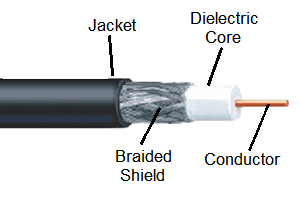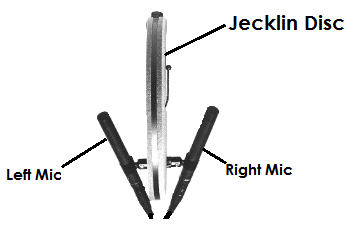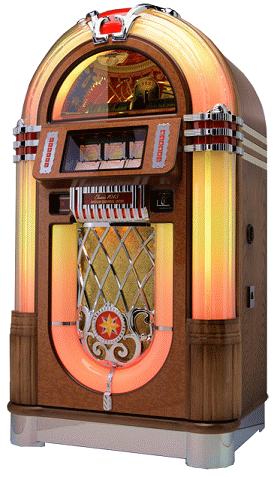——— J ———
J – the symbol for joule.
jack – the receptacle into which a plug or other input device is inserted. A plug is a male connector and a jack is a female connector.
jack bay – see patch bay.

jacket – the layer of material surrounding a wire or cable that provides insulation and protection. Also called a sheath or insulation.
jackfield – a British term for patch bay.
jack plug – see phone plug.
jack socket – see phone jack.
JAES – Journal of the Audio Engineering Society. The official publication of the AES, which covers audio technology, and contains state-of-the-art technical papers, engineering reports, and articles on audio topics, education and standards, and other topics in the field of audio.
jam – (1) Short for jam session. (2) To improvise. (3) Improvised, impromptu, and unrehearsed music.
James Taylor tuning method – in order to accommodate problems with tuning acoustic guitars, James Taylor tunes his guitar strings slightly flat, as shown below. This method works especially well when using a capo, but the amount of correction varies by guitar, the amount of action, and how hard the guitar is played. See also True Temperament.
James Taylor Tuning Method |
|
| String | Tuning |
|---|---|
| High E | -3 cents |
| B | -6 cents |
| G | -4 cents |
| D | -8 cents |
| A | -10 cents |
| Low E | -12 cents |
jam session – an informal group of musicians that play improvised, impromptu, and unrehearsed music, especially jazz music.
jam sync – the process of regenerating a SMPTE timecode from an original source to replace a degraded or defective timecode or when copying a timecode from one tape to another. The generated code is called jam timecode, abbreviated as JTC.
jam timecode – see jam sync.
Japan Electronics and Information Technology Industries Association (JEITA) – a Japanes trade organization for the electronics and information technology industries.
Japanese Industrial Standards (JIS) – an organization that establishes specifications and standards for measurement in Japan. Although not encountered very often in the US, it is used in many other parts of the world.
JASA – Journal of the Acoustical Society of America. Published by the ASA since 1929, the JASA covers theoretical and experimental research results in sound, vibration, and acoustics.
jaws harp – the politically correct name for the Jew's harp.
Jay-Z-it – slang for getting a recording in one take.
JBL – a company that produces loudspeakers and amplifiers, headquartered in Northridge, California, a subsidiary of Harman International. It has two independent divisions: JBL Consumer, which produces audio equipment for the consumer market, and JBL Professional, which produces professional equipment for the recording studio, installed sound, sound reinforcement, portable sound, and motion picture industry. The company was founded in 1946 by James Bullough Lansing as Lansing Sound, Inc., but later changed its name to James B. Lansing Sound. In 1948, Marquardt acquired the company, but a year later Marquardt was purchased by the General Tire Company, which divested its interest in Lansing. The company was reincorporated as James B. Lansing Sound, Inc., and moved to Los Angeles. To resolve ongoing disputes with Altec Lansing Corporation, the company introduced the brand name JBL in 1955, but continued to operate under the same company name. In 1969, JBL was sold to the Jervis Corporation, which became Harman International.
J-card – the printed card inserted into a cassette tape box. It got its name because it resembles the letter “J” when viewed from the end.
JEDEC – Joint Electron Device Engineering Council.
JEDEC Solid State Technology Association – an independent engineering trade organization and standardization body, comprised of semiconductor and computer companies. Formerly known as the Joint Electron Device Engineering Council (JEDEC), it was founded in 1958 jointly by the Electronic Industries Alliance (EIA) and the National Electrical Manufacturers Association (NEMA) to develop standards for semiconductor devices. NEMA discontinued its involvement in 1979. The EIA ceased operations in 2011, dividing its activities into several divisions divisions, including JEDEC.

Jecklin disc technique – a stereo microphone technique that uses two condenser microphones separated by a distance of 16.5 cm (about 6.5 inches) between which a 30-cm (11.8-inch) acoustically muffled disc is inserted. It was invented by Jürg Jecklin, the former chief sound engineer of Swiss Radio. Also called the OSS technique (OSS stands for optimum stereo signal). This technique is in the baffled-microphone category. Other techniques in this category include baffled-omni pair, Schneider disc technique, wedge technique, and sphere microphone.
JEITA – Japan Electronics and Information Technology Industries Association.
jellyfish display – see goniometer.
Jensen Electronics – a consumer electronics company founded in 1915 by Peter Jensen, who invented the first loudspeaker. Over the years the Jensen brands grew to include Acoustic Research (AR), Phase Linear, and NHT (Now Hear This). In Germany brands included Magnat and Macaudio. In 2004, Audiovox Corporation (now VOXX International) acquired the Jensen line.

Jew's harp – a small lyre-shaped musical instrument made of metal and held between the teeth, having a small steel projection that is plucked with a finger to produce a soft twanging sound. Although it can produce only one sound, different notes are sounded by the player altering the shape of the mouth cavity. For political correctness, the name “jaws harp” has been proposed.
jiffy – (1) An informal term meaning a short period of time. (2) A time period equal to one cycle of alternating current (1⁄50 or 1⁄60 sec). (3) One tick of the system timer on a computer, which varies with the computer.
JIS – Japanese Industrial Standards.
jitter – see digital jitter or intersymbol interference.
jnd – see just noticeable difference.
jog – (1) To make minute location changes on a recording tape or digital audio track. (2) To use a jog wheel to control the transport of a tape machine to make very small adjustments in position, usually to locate an exact location for an edit. Some digital audio workstation have such capabilities. Jog refers to moving very slowly, while shuttle refers to moving very fast.

jog wheel – a type of knob, ring, wheel, or dial that allows the user to make small adjustments in position of a recording tape or digital audiotrack. Sometimes called a wheel for short.
Johnson noise – see thermal noise.
Johnson-Nyquist noise – see thermal noise.
joint – (1) The point at which two pieces of recording tape are spliced together during editing. (2) See pot, definition #2.
Joint Picture Expert Group (JPEG) – the group that defined a standard for data compression for still images, with the file extensions .jpg and .jpeg.
joint coupling – see channel coupling.
joint stereo – the property of an audio data stream that supports more than one method of stereo encoding, such as SS, MS, or IS. A joint stereo stream may use only a single encoding method or may switch between methods for efficiency or quality. There are three MP3 stereo encoding methods or modes: (a) SS (simple stereo, L/R stereo, dual stereo, or dual mono) - coding in which each channel is treated as completely separate signals. SS can be inefficient and may adversely impact sonic quality compared to other methods, especially when both channels contain nearly identical signals. (b) MS (mid-side stereo) - coding that creates a mid-side matrix using the sum and difference of the left and right stereo signals. Whenever both channels contain nearly identical signals, mid-side stereo can achieve a significant saving in bitrate, because it can use fewer bits to encode the side-channel. Another important fact is that quantization noise in the middle of the stereo image, where it is masked by the signal. MS coding also keeps the phase information, unlike intensity stereo which deletes phase information. MS stereo maintains a good stereo image while increasing compression efficiency by either reducing the file size or increasing sonic quality. (c) IS (intensity stereo) - coding that reduces bitrates by replacing the left and the right signal with a single stream that includes the signal plus directional information. Human hearing is insensitive to the signal phase at frequencies above approximately 2 kHz so that this replacement is psychoacoustically justified. IS is a lossy coding method and is primarily useful at low bitrates. For coding at higher bitrates only MS stereo should be used. See also channel coupling.
Joint Task Force on Networked Media (JT-NM) – an organization created to help manage the transition from broadcast infrastructures that are based on specialty broadcast equipment and interfaces, such as SDI and AES, to information technology (IT)-based packet networks, such as Ethernet and IP. The JT-NM is sponsored by the European Broadcasting Union (EBU), the Society of Motion Picture and Television Engineers (SMPTE), and the Video Services Forum (VSF).
joule (J) – the SI unit for energy, work, or heat. It is equal to the force, energy, or work done by applying a force of one newton through a distance of one meter (1 newton-meter), or about 1⁄3600 of a watt. It is also equal to the of energy needed to pass an electric current of one ampere through a resistance of one ohm for one second (1 watt-second) or the work required to move an electric charge of one coulomb through an electrical potential difference of one volt (1 coulomb-volt). One BTU of heat is equivalent to approximately 1055 joules. It is named for James Prescott Joule, the English physicist who discovered the first law of thermodynamics.
JPEG – Joint Picture Expert Group.

JTC – Jam Time Code. See jam sync.
JT-NM – Joint Task Force on Networked Media.
jukebox – (1) A coin-operated phonograph, typically having a colorful, illuminated cabinet, originally containing records, but later, CDs replaced the records. Usually a specific song can be selected by entering a combination of letters and numbers on pushbuttons. (2) A software device that stores and catalogs audio files.
jukebox bass – a slang term for an undesirable underdamped, boomy bass response with significant overhang.
jump – see bounce or channel jumping.
jump cut – an edit between two video shots or audio soundbites that creates the effect of discontinuity or acceleration.
jump drive – see USB flash drive.
jumper – a connector or small piece of wire used to make a connection between two points on a circuit board. Jumpers are often used to allow end users to change the configuration of equipment. See also jumper cable.
jumper cable – (1) A cable used to make a temporary contact between two points when testing an electronic circuit. (2) A patch cord.
just interval – see just intonation.
just intonation – a tuning system or temperament in which the frequencies of notes are related by ratios of whole number. An interval tuned in this manner is called a just interval. It is not very useful in practice because most instruments tuned in just intonation would have to be retuned to change keys. See table below. Also called Ptolemaic tuning, just temperament, pure temperament, or pure intonation. See also Pythagorean tuning, mean-tone temperament, harmonic series tuning, and equal temperament.
| Musical Interval | Frequency Ratio to Tonic | Interval (Cents) | Comparison to Equal Temperament |
|---|---|---|---|
| Tonic | 1:1 | 0 | 0 |
| Minor Second | 16:15 | 112 | 100 |
| Major Second | 9:8 | 204 | 200 |
| Minor Third | 6:5 | 316 | 300 |
| Major Third | 5:4 | 386 | 400 |
| Fourth | 4:3 | 498 | 500 |
| Dimished Fifth | 7:5 | 583 | 600 |
| Fifth | 3:2 | 702 | 700 |
| Minor Sixth | 8:5 | 814 | 800 |
| Major Sixth | 5:3 | 884 | 900 |
| Minor Seventh | 16:9 | 996 | 1000 |
| Major Seventh | 15:8 | 1088 | 1100 |
| Octave | 2:1 | 1200 | 1200 |
just noticeable difference (jnd) – a psychoacoustic term for the smallest difference the human ear is capable of detecting. For amplitude, the jnd for humans is about 1dB. For timing differences, the jnd is about 6 ms. For tones, the jnd depends on the tone's frequency. Below 500 Hz, the jnd is about 3 Hz for sine waves and 1 Hz for complex tones. Above 1000 Hz, the jnd for sine waves is about 0.6%.
just temperament – see just intonation.
JVC – Victor Company of Japan, Ltd. A manufacture of audio, visual, and computer-related electronics and software and media located in Yokohama, Japan. In 2008, JVC merged with the Kenwood Corporation to form JVC Kenwood Holdings.
Note: We believe this is the largest dictionary (glossary) of terms specific to usage within the recording industry that is currently available on the internet, with more than 8,800 entries, nearly 800 illustrations, and dozens of tables. Some of the terms have different or additional meanings in other situations, especially within the electronic, automotive, scientific, and computer industries. Of necessity there are obvious overlaps into other fields such as music, electronics, and computers, but such excursions are limited to information deemed pertinent to the knowledge required to operate and/or participate effectively in the workings of a recording studio. Also included are terms related to sound reinforcement (live performances) including wireless microphone technology because a working knowledge of that terminology is necessary for recording at live performance venues. Because recording studios also record audio for video and motion pictures (films), some terminology from those fields is included. Some scientific terms are included because they help explain studio terminology. For example, electromagnetism explains how microphones, loudspeakers, and guitar pickups work. Knowledge of radio waves and the radio frequency spectrum is needed to explain wireless devices. Any trademarks or trade names mentioned belong to their respective owners. The information contained in this dictionary is believed to be accurate at the time of publication. This information is subject to change without notice. The information was obtained from and cross-checked with a variety of sources that are believed to be reliable. However, Los Senderos Studio, LLC does not guarantee the accuracy or completeness of the information contained herein. Please contact us to report any errors, omissions, discrepancies, or broken links. Los Senderos Studio shall not be responsible for any consequences or damages arising out of the use of this information. Nothing in this glossary should be interpreted as legal advice. For a glossary providing information on legal and business matters for musicians, we suggest you consult Musicians Business Dictionary.
A note on alphabetical order: The terms in this glossary are alphabetical without regard to spaces and punctuation. For example, AM Radio follows amplitude. While this may seem to be at odds with other conventions, it eliminates confusion with words such as pickup, which is sometimes written as pick up or pick-up. In addition, all symbols such as &, -, or / are ignored. The entries on the number page (0-9) are listed in increasing value within each digit. For example, all of the entries beginning with 1 are listed before those starting with 2. For Greek letters (α-ω), the entries are in Greek alphabetical order.


